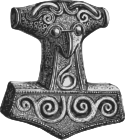- Hrungnir
-
Hrungnir (Old Norse "brawler"[1]) was a jötunn in Norse mythology, slain by the god Thor with his hammer Mjölnir. The account is documented in the Skáldskaparmál, in the Prose Edda by Snorri Sturluson.
Prior to his demise, Hrungnir engaged in a wager with Odin in which Odin stakes his head on his horse, Sleipnir, being faster than Hrungnir's steed Gullfaxi. During the race, which Sleipnir wins, Hrungnir enters Valhalla, and there becomes drunk and abusive. After they grow weary of him, the gods call on Thor to battle Hrungnir.
Contents
The fighting and the enchantment afterwards
Thor and his servant Thjalfi challenge the giant, who hurls his whetstone weapon at Thor. Smashed to smithereens by Thor's hammer Mjölnir, fragments of the whetstone fall down to earth, while one shard sinks deep into the god's forehead. Nevertheless, the hammer strikes Hrungnir dead, shattering his skull; but in his fall, Hrugnir's dead body topples over Thor, leaving the god buried under one of his legs.
When both Thjalfi and the combined strength of the Aesir fail at pushing and pulling the giant's foot off Thor's throat, Magni, Thor's infant son with the giantess Jarnsaxa, passes by and easily lifts the foot, rebuking his father for his weakness. Back in Asgard, the sorceress Groa is called upon to remove Hrungnir's whetstone from Thor's forehead. As her enchantments are beginning to show an effect, gradually loosening the stone, Thor promises to generously reward her for her services, mentioning that he had recently helped her husband Aurvandil cross the icy river Eliwagar and that it would not be long for her to be reunited with him. Rejoicing at these news, Groa, in her excitement, forgets all about her chants, thus leaving the whetstone locked in Thor's forehead.
Attributes
His heart had a peculiar shape, it was triangular due to which both the Valknut and the Triquetra have been called Hrungnir's heart.
Source text
They regarded it very important who should gain the victory, and they feared the worst from Thor if Hrungnir should be defeated, for he was the strongest among them. Thereupon the giants made at Grjöttungard a man of clay, who was nine rasts tall and three rasts broad under the arms, but being unable to find a heart large enough to be suitable for him, they took the heart from a mare, but even this fluttered and trembled when Thor came. Hrungner had, as is well known, a heart of stone, sharp and three-sided; just as the rune has since been risted that is called Hrungner's heart. Even his head was of stone. His shield was of stone, and was broad and thick, and he was holding this shield before him as he stood at Grjottungard waiting for Thor. His weapon was a flint-stone, which he swung over his shoulders, and altogether he presented a most formidable aspect. On one side of him stood the giant of clay, who was named Mokkerkalfe. He was so exceedingly terrified, that it is said that he wet himself when he saw Thor.....But the hammer Mjölner hit Hrungner right in the head, and crushed his skull in small pieces. He himself fell forward over Thor, so that his foot lay upon Thor's neck. Meanwhile Thjalfe attacked Mokkerkalfe, who fell with but little honor.[2]
Notes
- ^ Orchard (1997:91).
- ^ from Skáldskaparmál
References
- Orchard, Andy (1997). Dictionary of Norse Myth and Legend. Cassell. ISBN 0-304-34520-2
See also
Conchobar mac Nessa, an Irish king from the Ulster Cycle, who is wounded in a very similar manner by Cet mac Magach.
Norse paganism Deities,
heroes,
and figuresOthersAsk and Embla · Dís (Norns · Valkyries) · Dwarf · Einherjar · Elves (Light elves · Dark elves) · Fenrir · Hel · Jörmungandr · Jötunn · Sigurd · Völundr · Vættir
Locations Asgard · Bifröst · Fólkvangr · Ginnungagap · Hel · Jötunheimr · Midgard · Múspellsheimr · Niflheim · Valhalla · Vígríðr · Wells (Mímisbrunnr · Hvergelmir · Urðarbrunnr) · YggdrasilEvents Sources Society See also Categories:- Jötnar
Wikimedia Foundation. 2010.

